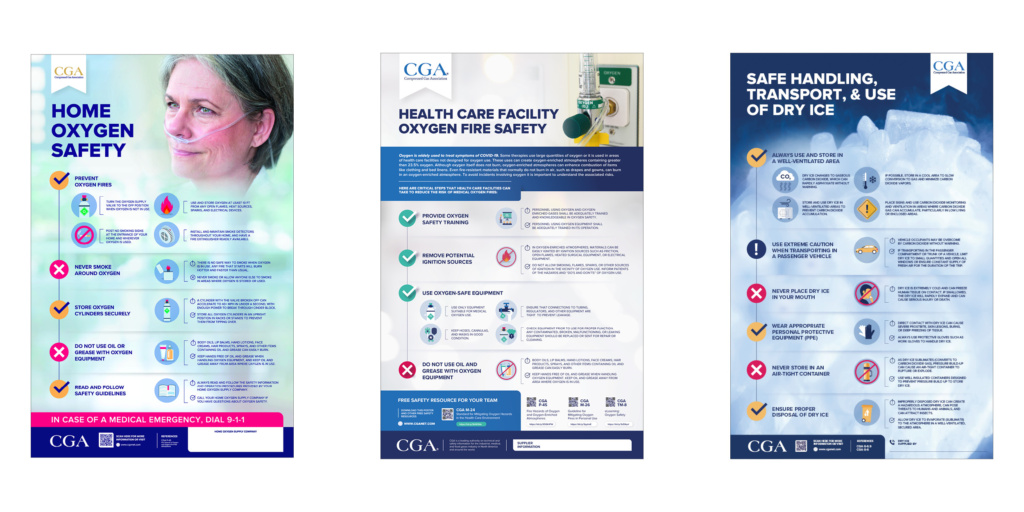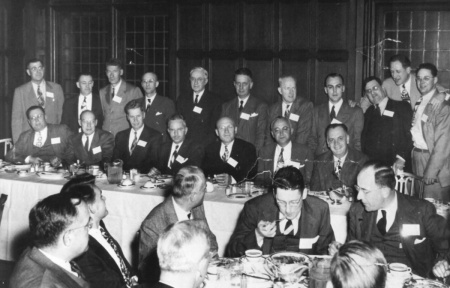As GAWDA members know, medical oxygen has played an essential role in delivering patient care during the COVID-19 pandemic. Some therapies require large quantities of oxygen or its use in areas of health care facilities not designed for oxygen use, which can create oxygen-enriched atmospheres containing greater than 23.5% oxygen. Although oxygen itself does not burn, in oxygen-enriched atmospheres, materials can be easily ignited by ignition sources such as friction, open flames, heated surgical equipment, or electrical equipment.
To avoid incidents involving oxygen and oxygen-enriched atmospheres, it is important that health care personnel handling and using these gases and associated equipment understand the associated risks and mitigation practices.
To this end, the Compressed Gas Association (CGA) is offering a number of safety resources for health care professionals, to help keep personnel, patients, and communities safe. We ask that members of the GAWDA community help us spread the word about these resources by sharing them widely with your customers and other stakeholders.
CGA Publishes New Poster on Health Care Facility Oxygen Fire Safety
The poster, Health Care Facility Oxygen Fire Safety, published recently by the Compressed Gas Association, provides basic safety information for health care environments where medical oxygen is in use. It includes critical steps that health care facilities can take to reduce the risk of medical oxygen fires, including the following safety messages:
Medical Oxygen Fire Safety Reminders
Provide Oxygen Safety Training
- Personnel using oxygen and oxygen-enriched gases shall be adequately trained and knowledgeable in oxygen safety.
- Personnel using oxygen equipment shall be adequately trained in its operation.
Remove Potential Ignition Sources
- Do not allow smoking, flames, sparks, or other sources of ignition in the vicinity of oxygen use.
- Inform patients of the hazards and “Do’s and Don’ts” of oxygen use.
- Use Oxygen-Safe Equipment
- Use only equipment suitable for medical oxygen use.
- Ensure that connections to tubing, regulators, and other equipment are tight to prevent leakage.
- Keep hoses, cannulas, and masks in good condition.
- Check equipment prior to use for proper function.
Do Not Use Oil and Grease with Oxygen Equipment
- Body oils, lip balms, hand lotions, face creams, hair products, sprays, and other items containing oil and grease can easily burn.
- Keep hands free of oil and grease when handling oxygen equipment.
- Keep oil and grease away from area where oxygen is in use.
As with all CGA safety posters, this poster is provided as a scalable PDF file, enabling users to print the size they need. The posters are also designed for easy co-branding: GAWDA members can add their company information to the “Supplier Information” box at the bottom of the poster, before sharing this valuable safety resource.
For more information and to download this free safety poster, see: bit.ly/MedicalOxygenSafety.
CGA Offers Complimentary Access to Publication for Mitigating Oxygen Hazards in Health Care Environments
As medical oxygen has become the most important treatment for COVID-19 over the past year, it has become critically important for health care personnel to understand and learn to mitigate the risks of working with this compressed medical gas. Safety publication, CGA M-24, Standard for Mitigating Oxygen Hazards in the Health Care Environment (Formerly SB-31), provides general requirements for personnel handling and using oxygen and oxygen-rich gases and associated equipment in health care environments.
For many applications in the medical field, gaseous and liquid oxygen are used or administered in equipment such as liquid oxygen base and portable units, oxygen concentrators, oxygen tents, incubators, and hyperbaric chambers. In addition, oxygen is widely used to treat symptoms of COVID-19.
While oxygen is not flammable itself, it supports and accelerates combustion. Materials that normally do not burn in air, such as the metal in oxygen regulators, plastic tubing used to supply oxygen, or fire-resistant drapes and gowns, can burn in an oxygen-enriched atmosphere, as can clothing and bed linens.
Materials that can be ignited in air require less energy to ignite in the presence of an oxygen-rich gas or oxygen-rich atmosphere. Many of these materials can be ignited by different sources of ignition such as friction or expansion when oxygen at high pressure is rapidly introduced into a system that is initially at low pressure. For equipment containing or using liquid oxygen there needs to be an additional awareness of its low temperature properties, to prevent against accidents involving frostbite and cold burns.
The Compressed Gas Association is providing safety publication CGA M-24 free of charge for all those who may need it, to help ensure that all health care facilities and their employees have access to the necessary information to facilitate a safe response to the COVID-19 pandemic. This publication may be downloaded at: bit.ly/CGAPubM-24Info.
Engaging Directly with Health Care Organizations
Where feasible and appropriate, CGA has also engaged directly with health care organizations and facilities, providing resources and technical knowledge, in an effort to help these organizations and their personnel safely battle COVID.
For example, Compressed Gas Association staff learned from a January 29, 2021 Los Angeles Times article that a state task force was building oxygen supply depots in an effort to alleviate oxygen supply and distribution issues in California. The article noted that depots, staffed by personnel from the California Emergency Medical Services Authority (EMSA), were using oxygen concentrators to fill cylinders for hospitals.
On February 11, 2021, Rich Craig, CGA’s Vice President, Technical & Regulatory Affairs, sent a message to Dr. Dave Duncan, EMSA’s Director, offering a set of medical oxygen safety resources and safe practices, to aid EMSA in the safe rollout of its oxygen supply depots.
These resources included the following publications from CGA’s safety library, provided to EMSA on a complimentary basis:
- CGA C-6, Standard for Visual Inspection of Steel Compressed Gas Cylinders;
- CGA C-6.1, Standard for Visual Inspection of High-Pressure Aluminum Alloy Compressed Gas Cylinders;
- CGA C-6.2, Standard for Visual Inspection and Requalification of Fiber Reinforced High Pressure Cylinders;
- CGA G-4, Oxygen;
- CGA P-15, Standard for the Filling of Industrial and Medical Nonflammable Compressed Gas Cylinders;
- CGA P-83, Guidelines for Cleaning Externally Contaminated Medical Gas Containers; and
- CGA SA-24, Safety Alert, Emergency Medical Services Filling Oxygen or Air for Human Respiration.
To help ensure the safety of recovering COVID-19 patients sent home from hospitals with medical oxygen cylinders, we also highlighted the availability of our Home Oxygen Safety poster, which is available for free download from our website at: https://www.cganet.com/home-oxygen-safety/.
Dr. Duncan promptly replied to Rich Craig’s message, indicating that CGA’s information about the safe use of medical oxygen “will be incorporated into our operations and safety documentation.”










